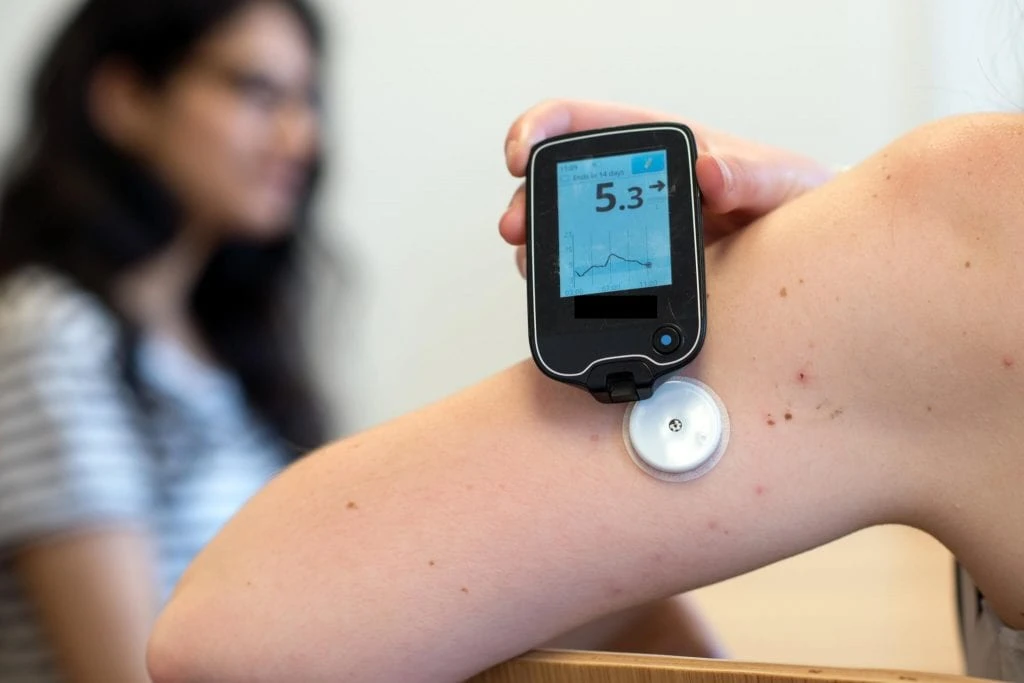What is a CGM?
A CGM is a continuous glucose monitor. It is a small system that monitors your blood glucose (sugar) levels in real-time. This means it can show you how your blood sugar changes in response to different foods and meals.
Benefits of a CGM
CGMs were developed for people with diabetes. However, they can also be useful for many people without diabetes. Using a CGM will allow you to understand how your body responds to different types and amounts of carbohydrates, as well as other factors such as exercise.
Knowing how your body responds can help your healthcare team to make early diagnoses, as well as help you make dietary changes to control your blood sugars, slow (or stop!) the progression of prediabetes and even reduce your risk of secondary conditions.
Typically, blood sugars levels increase after meals – even in people without diabetes. A CGM may also be useful for people without diabetes or high glycosylated hemoglobin (HbA1cs) but are prone to large changes in blood sugar levels. Large swings in blood sugar levels can cause calorie-dense cravings and symptoms of hypoglycemia such as,
-
- Dizziness
- Hunger
- Fast heartbeat
- Trouble concentrating
- Irritability
- Headache
For a comprehensive list of hypoglycemia symptoms, visit American Diabetes Association’s article on hypoglycemia. You can learn more about the typical changes in blood sugar from HealthLink BC.
What CGMs Cannot Do
Although CGMs can give us a ton of information, they cannot do everything. Continuous glucose monitors can not be used to address weight issues. This is because weight loss is associated with a calorie, not carbohydrate, deficit. In other words, limiting the amount, or glycemic index, of carbohydrates in your diet will not lead to weight loss. It is entirely possible for your diet to not have a significant impact on your blood sugar levels, but still provide you with more calories than your need.
You can learn more about the role of our diet in weight loss from my post on weight loss.
People Who Should Try a CGM
It should come as no surprise that many people with diabetes use CGM, but these little systems are useful for other people as well!
People with a family history or who are at risk for diabetes are great candidates for trying the CGM system. As you may already know, there is a genetic aspect of diabetes. You are 4 times more likely to develop diabetes if a member (or members) of your family has been diagnosed with either type 1 or type 2. Using a continuous glucose monitor can help you identify early signs of diabetes such as insulin resistance that may otherwise go undetected.
You may also benefit from trying a continuous glucose monitor if you have a borderline glycosylated hemoglobin (HbA1c) score or poor glucose tolerance scores. HbA1c scores are essentially the average of your blood sugar over 3 months. This means it is possible to experience big changes in blood sugar levels and have a normal, or higher-than-average HbA1c score. A continuous glucose monitor can help identify large changes in blood sugar and support early treatment or prevention of diabetes.
Additionally, if you are experiencing gestational diabetes (pregnancy-related diabetes), you may also benefit from using a CGM. Using a continuous glucose monitor can help you control your blood sugars better throughout pregnancy. Some studies suggest that this can reduce the risk of complications, but more research is needed to confirm.
People Who Should Avoid Using a CGM
Despite all the benefits, a CGM is not for everyone. If you have been diagnosed with an eating disorder, or find yourself worrying about your daily calorie or food intake, then a CGM probably is not right for you. Before trying a continuous glucose monitor system, ask yourself,
-
- How often am I preoccupied with thoughts about food?
- Do I often worry about my weight or body size?
- Am I worried about certain health concerns?
Unfortunately, using a CGM can increase these obsessive thoughts. In other words, if you spend a large portion of your day worrying about these areas, it may not be a good fit for you.
Additionally, if your health goal is weight-based, you may want to reconsider using a CGM as these systems do not necessarily lead to weight loss.
CGM Costs
Unfortunately, CGMs are not currently covered by the provincial healthcare systems. This means there is an out-of-pocket cost associated with them.
There are many different types of CGM systems available including Abbot’s FreeStyle Libre and Dexcom D6, which do not require a prescription.. You can purchase the FreeStyle Libre system from Costco for $88.

Talk to your doctor or registered dietitian to learn more and find out if a CGM is right for you.
Get a CGM Sample!
Are you looking to take your blood sugar management to a new level? Book a FREE discovery call today for more information and a FreeStyle Libre sample!
References
Annis, A. M., Caulder, M. S., Cook, M. L., Duquette, D., & for CDC, C. (1999). Family History, Diabetes, and Other Demographic and Risk Factors Among Participants of the National Health and Nutrition Examination.
Continuous Glucose Monitor (CGM). (n.d.). In Diabetes Canada. Retrieved February 20, 2022, from https://www.diabetes.ca/DiabetesCanadaWebsite/media/Managing-My-Diabetes/Tools%20and%20Resources/Continuous_Glucose_Monitoring_Advocacy_Pkg_4.pdf?ext=.pdf
Diabetic hypoglycemia. (n.d.). Mayo Clinic. Retrieved February 20, 2022, from https://www.mayoclinic.org/diseases-conditions/diabetic-hypoglycemia/symptoms-causes/syc-20371525
Family Health History and Diabetes. (2020, November 10). CDC. https://www.cdc.gov/genomics/famhistory/famhist_diabetes.htm
Healthwise Staff. (2020, August 31). Diabetes: Blood Sugar Levels. HealthLink BC. https://www.healthlinkbc.ca/illnesses-conditions/diabetes/diabetes-blood-sugar-levels
Murphy, H. R., Rayman, G., Lewis, K., Kelly, S., Johal, B., Duffield, K., Fowler, D., Campbell, P. J., & Temple, R. C. (2008). Effectiveness of continuous glucose monitoring in pregnant women with diabetes: randomised clinical trial. BMJ, 337(sep25 2), a1680–a1680. https://doi.org/10.1136/bmj.a1680
Polsky, S., & Garcetti, R. (2017). CGM, Pregnancy, and Remote Monitoring. Diabetes Technology & Therapeutics, 19(S3), S-49-S-59. https://doi.org/10.1089/dia.2017.0023
What is HbA1c? (n.d.). Diabetes UK. Retrieved February 17, 2022, from https://www.diabetes.org.uk/guide-to-diabetes/managing-your-diabetes/hba1c
With a Bachelor of Science in Nutrition and Food Science, Rachel has over 15 years’ experience helping people address their health through nutrition.


